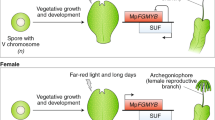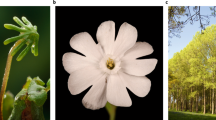Abstract
THE modern cycads are the remnant of a gymnosperm group that has been in existence for at least 200 Myr1. Cycads are dioecious, with separate male and female plants, and fertilisation is effected by motile male gametes—so-called zooidogamous reproduction. Zooidogamy is found also in Ginkgo, another dioecious gymnosperm of considerable antiquity1. Reproduction in all other gymnosperms and in flowering plants is siphonogamous. Here fertilisation occurs through a pollen tube which conveys the non-motile male gamete to the egg. A pollen tube is produced in the zooidogamous gymnosperms, but it is not involved in gamete transfer; it simply anchors the male gametophyte to the ovule during gametogenesis (Fig. 1). The ripe male gametes are released to swim freely in a pool of fluid bathing the openings of the egg-containing archegonia (Fig. 1). It is not known how the gametes that carry out fertilisation are selected in these plants. Dioecism ensures outcrossing, but there is presumably some form of intraspecific screening. The male gametophyte or male gamete could, for example, identify itself to the parent of its prospective mate, or the male gamete to the egg cell at the threshold of syngamy. I report here the occurrence in cycads of proteins and glycoproteins at sites in the pollen grain and ovule where they might be involved in reproduction.
This is a preview of subscription content, access via your institution
Access options
Subscribe to this journal
Receive 51 print issues and online access
$199.00 per year
only $3.90 per issue
Buy this article
- Purchase on Springer Link
- Instant access to full article PDF
Prices may be subject to local taxes which are calculated during checkout
Similar content being viewed by others
References
Sporne, K. R. The Morphology of Gymnosperms (Hutchinson, London, 1965).
Pearse, A. G. E. Histochemistry 3rd edn. 2 (Churchill-Livingstone, London and Edinburgh, 1972).
Pearse, A. G. E. Histochemistry 3rd edn. 1 (Churchill-Livingstone, London and Edinburgh, 1968).
Graham, R. C. & Karnovsky, M. J. J. Histochem. Cytochem. 14, 291–302 (1966).
Bowers, B. & Korn, E. D. J. Cell. Biol. 62, 533–540 (1974).
Laemmli, U. K. & Favre, M. J. molec. Biol. 80, 575–599 (1973).
Knox, R. B. & Heslop-Harrison, J. J. Cell Sci. 6, 1–27 (1970).
Knox, R. B. J. Cell Sci. 9, 209–237 (1971).
Knox, R. B. & Heslop-Harrison, J. Nature 223, 92–94 (1969).
Heslop-Harrison, J. Proc. R. Soc., Lond. B 190, 275–299 (1975).
Sahni, B. New Phytol. 14, 149–151 (1915).
Lee, C. J. Bot. Gaz. 117, 79–100 (1955).
Pettitt, J. M. Proc. R. Soc., Lond B 195, 497–515 (1977).
Heslop-Harrison, J., Heslop-Harrison, Y., Knox, R. B. & Howlett, B. Ann. Bot. 37, 403–412 (1973).
Knox, R. B., Heslop-Harrison, J. & Heslop-Harrison, Y. Biol. J. Linn. Soc. 7, Suppl. 1, 177–187 (1975).
Vithange, H. I. M. V. & Knox, R. B. J. Cell Sci. 21, 423–435 (1976).
Lis, H. & Sharon, N. A. Rev. Biochem. 42, 541–574, (1973).
Watson, L., Knox, R. B. & Creaser, E. H. Nature 249, 574–576 (1974).
Mattsson, O., Knox, R. B., Heslop-Harrison, J. & Heslop-Harrison, Y. Nature 247, 298–300 (1974).
Heslop-Harrison, J., Heslop-Harrison, Y. & Barber, J. Proc. R. Soc., Lond. B 188, 287–297 (1975).
Heslop-Harrison, J., Knox, R. B., Heslop-Harrison, Y. & Mattsson, O. Biol. J. Linn. Soc. 7, Suppl. 1, 189–202 (1975).
Heslop-Harrison, Y. Micron 7, 33–36 (1976).
Knox, R. B., Clarke, A., Harrison, S., Smith, P. & Marchalonis, J. J. Proc. natn. Acad. Sci. U.S.A. 73, 2788–2792 (1976).
Nicolson, G. L. Int. Rev. Cytol. 39, 89–190 (1974).
Clarke, A. E., Knox, R. B. & Jermyn, M. A. J. Cell Sci. 19, 157–167 (1975).
Burgess, J. & Linstead, P. J. Planta. 130, 73–79 (1976).
Author information
Authors and Affiliations
Rights and permissions
About this article
Cite this article
PETTITT, J. Detection in primitive gymnosperms of proteins and glycoproteins of possible significance in reproduction. Nature 266, 530–532 (1977). https://doi.org/10.1038/266530a0
Received:
Accepted:
Issue Date:
DOI: https://doi.org/10.1038/266530a0
This article is cited by
-
Bipolar pollen germination in blue spruce (Picea pungens)
Protoplasma (2019)
-
Developmental evolution of flowering plant pollen tube cell walls: callose synthase (CalS) gene expression patterns
EvoDevo (2011)
-
Fertilization and rejection of spermatozoids by egg cells in artificially pollinated ovules ofEncephalartos (Zamiaceae)
Sexual Plant Reproduction (1996)
-
Recognition and rejection phenomena during pollen-pistil interaction
Proceedings / Indian Academy of Sciences (1979)
Comments
By submitting a comment you agree to abide by our Terms and Community Guidelines. If you find something abusive or that does not comply with our terms or guidelines please flag it as inappropriate.



